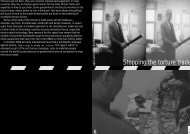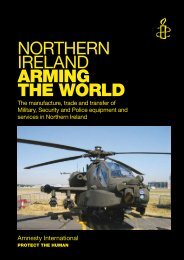CROWD CONTROL TECHNOLOGIES - Omega Research Foundation
CROWD CONTROL TECHNOLOGIES - Omega Research Foundation
CROWD CONTROL TECHNOLOGIES - Omega Research Foundation
You also want an ePaper? Increase the reach of your titles
YUMPU automatically turns print PDFs into web optimized ePapers that Google loves.
used CS gas to literally fumigate anti-government demonstrations on a scale in a different league to<br />
even that used by the Police at the anti-WTO demonstrations in Seattle last year, but on a routine basis<br />
week in, week out. Yet according to the LA Times, last year the South Korean police substituted their<br />
Darth Vader body armour and chemical fogging tactics with a move towards putting unarmed<br />
policewomen to the front lines during demonstrations to calm protestors. The results were impressive<br />
and instead of the 220,000 canisters of teargas used in 1997, in 1999 none were used. The only<br />
casualty was the Seoul based tear gas company Dae-A Chemical Industry which closed down last<br />
April. It is perhaps significant that because women face much steeper odds getting accepted into the<br />
police force in Seoul (only 1 in 200 women are accepted onto the force, whereas 1 in10 males applying<br />
are hired), police women tend to much better educated than their male counterparts. All are graduates<br />
of 4-year colleges, whereas only 80% of the men hold Bachelors degrees. 383 The lessons here are<br />
quite important, since the Korean Police Authorities have recognised that police-crowd confrontations<br />
are a process not a single event. More peaceful policing tactics can create more peaceful outcomes.<br />
The positive benefits are more than just less tear gas on the streets of Seoul. Now that fewer riot police<br />
are required, riot officers are being redeployed to traffic control and crime prevention. The European<br />
Parliament might like to learn more from the Seoul Police themselves by organising an official visit for<br />
relevant Members and Officers to meet with their European counterparts.<br />
7.4 CCTV Surveillance and Algorithmic Systems. One apparently seductive alternative option is the<br />
notion of substituting CCTV systems for public order riot squads. However, once a public order incident<br />
develops, security force commanders prefer the deployment of a real-time dispersal response. In that<br />
sense, any passive alternative is not useful in dealing with the immediate consequences, although<br />
CCTV networks could provide evidence after the event, of those involved in any incidents. What tends<br />
to happen in practice is that it is not a case of either crowd control weapons or CCTV but both and<br />
more. This is certainly the case in the UK where police and military officers have access to both<br />
alternatives. For example, )Heli Tele( helicopter mounted CCTV is frequently used to target )snatch<br />
squads( onto alleged ring-leaders. In situations such as Indonesia (where European companies have<br />
sold both airborne surveillance systems, crowd marking & dispersal systems, as well as powerful<br />
command, control & information computer systems) such targeting may have fatal consequences.<br />
Nevertheless, there are public order situations where CCTV might have both a deterrent effect and<br />
a positive role in identifying both hooligans and members of the police and security services who may<br />
have exceeded their remit. However even in the United Kingdom, which is the most heavily surveilled<br />
country in the EU, the ubiquitous presence of CCTV cameras does not dissuaded football hooligans<br />
from threatening and anti-social behaviour. Indeed, the most comprehensive recent survey of the utility<br />
of CCTV surveillance systems in preventing crime (undertaken for the Scottish Office by Professor<br />
Jason Ditton of the Scottish Centre for Criminology) found that they did not. Ditton said that )the<br />
cameras had not lived up to their early promise(. After four years of monitoring the monitors, the<br />
professor called for )an independent watchdog to oversee the use of the technology(. 384<br />
Members of the Committee will recall that a previous STOA document (PE 166.499) noted the<br />
emergence of face-recognition cameras but thought that deployment of such systems was five years<br />
away. Yet the Mandrake face-recognition system has already been deployed since November 1998 in<br />
Newham, London and has created the basis of a universal identity recognition network. Such systems<br />
work by scanning the geometry of faces in a crowd and recognising if they are held in a database of<br />
individuals of interest. They are not totally reliable generating reliable hits in a claimed 80% of cases<br />
which in the best case means a 1 in 5 chance of a false identification. 385<br />
The Newham system is being extended and if that process continues, the logic is a total<br />
surveillance society where everyones movements are tracked and eventually their speech and<br />
friendship networks as well. Few political systems, even in Europe, have enjoyed absolute certainty of<br />
long term stability within a democratic framework and there is no guarantee that such stability will<br />
continue. Any mass surveillance system is potentially much more than an anti-riot network and it is on<br />
balance probably wise to resist a universal extension of such schemes and keep them limited and<br />
local. 386<br />
lviii




